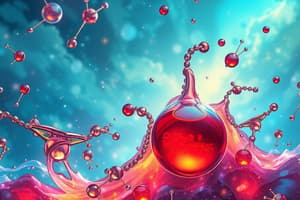Podcast
Questions and Answers
What are the two parts of a solution and their definitions?
What are the two parts of a solution and their definitions?
The two parts of a solution are the solvent, which is the substance that the solute dissolves in and forms the bulk of the solution, and the solute, which is the substance that dissolves in the solvent.
Give an example of a common type of solution.
Give an example of a common type of solution.
A common type of solution is when a solid, liquid, or gas dissolves in a liquid solvent.
Can solutions be formed by dissolving a solid in another solid?
Can solutions be formed by dissolving a solid in another solid?
Yes, solutions can be formed by dissolving a solid in another solid.
What is the importance of understanding the factors that affect solubility and the rate of dissolving in homes and industries?
What is the importance of understanding the factors that affect solubility and the rate of dissolving in homes and industries?
What is a solubility curve used for?
What is a solubility curve used for?
Which of the following is NOT a part of a solution?
Which of the following is NOT a part of a solution?
What is the substance that dissolves in the solvent called?
What is the substance that dissolves in the solvent called?
Which of the following is NOT a common type of solution?
Which of the following is NOT a common type of solution?
What is the substance that the solute or solutes dissolve in called?
What is the substance that the solute or solutes dissolve in called?
Which of the following is a factor that affects the solubility and the rate of dissolving of substances?
Which of the following is a factor that affects the solubility and the rate of dissolving of substances?
Flashcards are hidden until you start studying
Study Notes
Components of a Solution
- A solution consists of two parts: a solute, which is the substance that dissolves, and a solvent, which is the substance it dissolves in.
Formation of Solutions
- Solutions can be formed by dissolving a solid, liquid, or gas in a liquid solvent.
- However, solutions cannot be formed by dissolving a solid in another solid.
Importance of Solubility
- Understanding the factors that affect solubility and the rate of dissolving is crucial in both homes and industries, where it is used in various applications.
Solubility Curve
- A solubility curve is a graphical representation used to illustrate the relationship between the temperature of a solution and the maximum amount of solute that can dissolve at that temperature.
Identifying Solution Components
- The substance that dissolves in the solvent is called the solute.
- The substance that the solute dissolves in is called the solvent.
Factors Affecting Solubility
- Temperature is one of the factors that affect the solubility and rate of dissolving of substances.
Examples of Solutions
- A common type of solution is a homogeneous mixture, where the solute is uniformly distributed throughout the solvent.
- Gases, liquids, and solids can all be solutes in a solution.
Studying That Suits You
Use AI to generate personalized quizzes and flashcards to suit your learning preferences.




